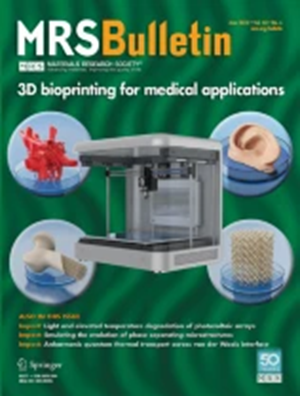相场模拟为腐蚀研究开辟新天地
IF 4.1
3区 材料科学
Q2 MATERIALS SCIENCE, MULTIDISCIPLINARY
引用次数: 0
摘要
本文概述了相场建模最近取得的一项新成就:将其应用于预测腐蚀前沿的演变和相关的结构完整性挑战。尽管腐蚀对社会具有重要影响,但预测腐蚀破坏一直是科学家和工程师难以实现的目标。将相场建模应用于腐蚀不仅可以跟踪电解质-金属界面,还为明确模拟潜在的中尺度物理过程提供了途径。这为开发第一代机理腐蚀模型奠定了基础,该模型可以捕捉到薄膜破裂和再钝化、从活化控制腐蚀到扩散控制腐蚀的转变、与机械场的相互作用、微结构和电化学效应、晶间腐蚀、材料生物降解以及与氢脆等其他环境辅助损伤现象的相互作用等关键现象。本文章由计算机程序翻译,如有差异,请以英文原文为准。

Phase-field simulations opening new horizons in corrosion research
This article overviews a new, recent success of phase-field modeling: its application to predicting the evolution of the corrosion front and the associated structural integrity challenges. Despite its important implications for society, predicting corrosion damage has been an elusive goal for scientists and engineers. The application of phase-field modeling to corrosion not only enables tracking the electrolyte–metal interface, but also provides an avenue to explicitly simulate the underlying mesoscale physical processes. This lays the groundwork for developing the first generation of mechanistic corrosion models, which can capture key phenomena such as film rupture and repassivation, the transition from activation- to diffusion-controlled corrosion, interactions with mechanical fields, microstructural and electrochemical effects, intergranular corrosion, material biodegradation, and the interplay with other environmentally assisted damage phenomena such as hydrogen embrittlement.
求助全文
通过发布文献求助,成功后即可免费获取论文全文。
去求助
来源期刊

Mrs Bulletin
工程技术-材料科学:综合
CiteScore
7.40
自引率
2.00%
发文量
193
审稿时长
4-8 weeks
期刊介绍:
MRS Bulletin is one of the most widely recognized and highly respected publications in advanced materials research. Each month, the Bulletin provides a comprehensive overview of a specific materials theme, along with industry and policy developments, and MRS and materials-community news and events. Written by leading experts, the overview articles are useful references for specialists, but are also presented at a level understandable to a broad scientific audience.
 求助内容:
求助内容: 应助结果提醒方式:
应助结果提醒方式:


